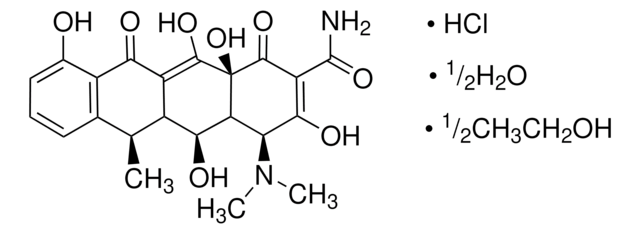197333
ABT-737
≥97% (HPLC), solid, Bcl-2 inhibitor, Calbiochem®
Synonim(y):
Bcl-2 Inhibitor VI, ABT-737, 4-{4-[(4ʹ-Chlorobiphenyl-2-yl)methyl]piperazin-1-yl}-N-{[4-({(1R)-3-(dimethylamino)-1-[(phenylsulfanyl)methyl]propyl}amino)-3-nitrophenyl]sulfonyl}benzamide
About This Item
Polecane produkty
product name
Bcl-2 Inhibitor VI, ABT-737, The Bcl-2 Inhibitor VI, ABT-737, also referenced under CAS 852808-04-9, controls the biological activity of Bcl-2. This small molecule/inhibitor is primarily used for Activators/Inducers applications.
Poziom jakości
Próba
≥97% (HPLC)
Postać
solid
producent / nazwa handlowa
Calbiochem®
warunki przechowywania
OK to freeze
protect from light
kolor
yellow
rozpuszczalność
DMSO: 50 mg/mL
Warunki transportu
ambient
temp. przechowywania
2-8°C
InChI
1S/C42H45ClN6O5S2/c1-46(2)23-22-35(30-55-37-9-4-3-5-10-37)44-40-21-20-38(28-41(40)49(51)52)56(53,54)45-42(50)32-14-18-36(19-15-32)48-26-24-47(25-27-48)29-33-8-6-7-11-39(33)31-12-16-34(43)17-13-31/h3-21,28,35,44H,22-27,29-30H2,1-2H3,(H,45,50)/t35-/m1/s1
Klucz InChI
HPLNQCPCUACXLM-PGUFJCEWSA-N
Opis ogólny
Opakowanie
Ostrzeżenie
Rekonstytucja
Inne uwagi
Oltersdorf, T., et al. 2005. Nature435, 677.
Informacje prawne
Kod klasy składowania
11 - Combustible Solids
Klasa zagrożenia wodnego (WGK)
WGK 3
Temperatura zapłonu (°F)
Not applicable
Temperatura zapłonu (°C)
Not applicable
Certyfikaty analizy (CoA)
Poszukaj Certyfikaty analizy (CoA), wpisując numer partii/serii produktów. Numery serii i partii można znaleźć na etykiecie produktu po słowach „seria” lub „partia”.
Masz już ten produkt?
Dokumenty związane z niedawno zakupionymi produktami zostały zamieszczone w Bibliotece dokumentów.
Klienci oglądali również te produkty
Nasz zespół naukowców ma doświadczenie we wszystkich obszarach badań, w tym w naukach przyrodniczych, materiałoznawstwie, syntezie chemicznej, chromatografii, analityce i wielu innych dziedzinach.
Skontaktuj się z zespołem ds. pomocy technicznej
